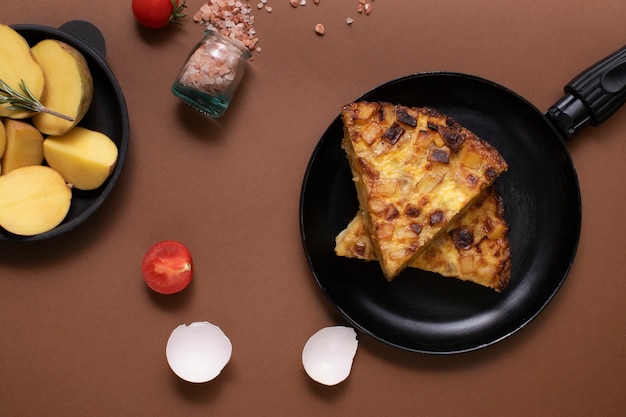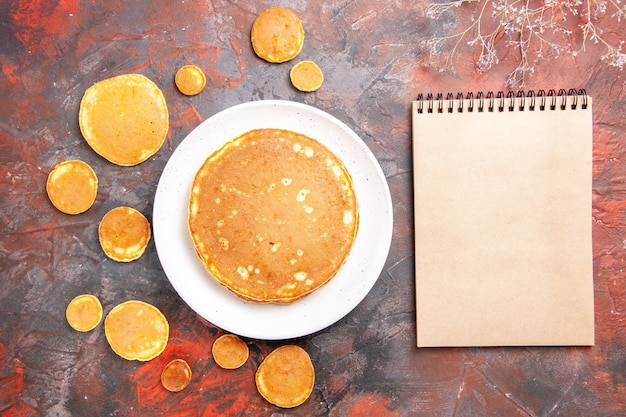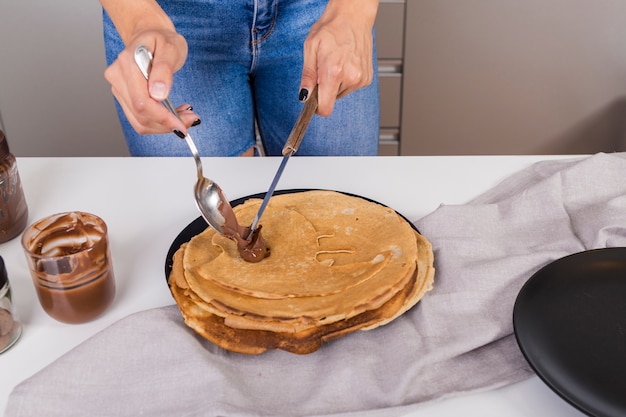Ah, pancakes. There's nothing quite like a stack of fluffy, golden-brown pancakes, drizzled with maple syrup and piled high with fresh fruit. But achieving that perfect texture and colour can be a bit of a culinary mystery. You know the feeling, right? One minute you're flipping a pancake that's stuck to the pan like glue, the next it's burning to a crisp before you can even say "syrup." The key to pancake perfection, my friends, lies in the temperature of your pan.
(Part 1) The Science of Pancake Perfection

Let's delve into the science behind a perfect pancake. The ideal pancake pan temperature is somewhere between medium-high and high heat, depending on your pan and the specific recipe you're using. But why does temperature matter so much? It all boils down to how heat affects the batter. If it's too hot, your pancakes will burn on the outside before the inside has a chance to cook through. Too low, and you'll end up with dense, greasy pancakes that are more like flatbreads.
The Heat-Batter Dance: Understanding the Science
Imagine the batter as a bunch of tiny dancers, each a tiny protein molecule, and the heat of your pan as the music. If the music is too loud (high heat), the dancers get all jittery and burn themselves. If the music is too soft (low heat), they get sluggish and don't move around enough. You want the perfect tempo, just right to let the dancers move gracefully and create a beautiful, fluffy pancake.
The heat of the pan influences the proteins in the batter. As the heat rises, these proteins denature, forming a network that traps air bubbles. This is what gives pancakes their fluffy texture. But too much heat can lead to the proteins becoming tough and rubbery, resulting in a dense, dry pancake.
(Part 2) The Golden Rule: Finding Your Perfect Temperature

So, how do we find that sweet spot? The easiest way is to rely on the old "hand test." This involves sticking your hand a few inches above the pan. If it feels comfortably warm, it's probably ready. But remember, this is just a general guideline. You’ll need to adjust based on your pan and the type of stove you have.
Feeling the Heat: The Hand Test
Here's how the hand test works:
- Turn your burner to medium-high heat.
- Wait a few minutes for the pan to heat up.
- Carefully hover your hand a couple of inches above the pan. Don't get too close, you don't want to burn yourself!
- If the heat feels comfortably warm, like a warm summer day, you're good to go.
- If it's too hot, turn down the heat a bit. If it's too cool, bump up the heat a touch.
Think of it like a gentle "hello" from your pan. It should say "hi, I'm ready to cook!"
(Part 3) The Visual Clues: Watching for Signs of Perfect Heat

Besides the hand test, keep an eye out for visual cues that tell you your pan is ready.
Pan Ready Signs
- The pan should be shimmering, almost like it's glistening with heat. The surface should look a bit "shiny," reflecting the light.
- A tiny drop of water should sizzle and evaporate quickly when added to the pan. If it just sits there, the pan isn't hot enough. Think of it like a mini-explosion of tiny bubbles.
(Part 4) From Theory to Practice: Tips for Temperature Control
Now that you understand the science, let's put it into action!
The Pan Choice
The pan you use makes a big difference. A good-quality non-stick pan will heat up evenly and release your pancakes easily. Avoid using old, scratched pans, as they can cause your pancakes to stick and burn. Look for a pan with a thick base, as it will hold heat more evenly.
The Heat Adjustment
You'll likely need to adjust the heat throughout the cooking process. If your pancakes start to brown too quickly, turn the heat down a little. If they're not browning enough, increase the heat slightly.
The Flip Factor
The timing of your flip is crucial. If you flip your pancakes too early, they’ll be soft and doughy in the middle. If you wait too long, they'll become overcooked and crispy. A good rule of thumb is to flip when you see bubbles appearing on the surface and the edges start to set. They should look a bit "firm" around the edges, and you should be able to lift them gently with a spatula.
(Part 5) Pancake Temperature Variations: Adjusting for Different Recipes
Not all pancakes are created equal. Some recipes call for thicker batter, while others use thinner batter. The type of ingredients also plays a role.
Thick Batter
For thicker batters, you might need to use a slightly higher temperature to ensure the pancakes cook through. But be careful not to burn them! You'll want to cook them a little longer on each side to ensure they're cooked all the way through.
Thin Batter
Thin batters tend to cook faster, so you may need to lower the heat a bit. They'll brown more quickly, so keep a close eye on them and don't let them burn.
Ingredient Considerations
Adding ingredients like nuts, chocolate chips, or fruit can impact how quickly the batter cooks. Be prepared to adjust the heat accordingly. The extra ingredients can make the batter a bit denser, so you might need to cook them a bit longer.
(Part 6) My Pancake Mishaps and Triumphs: A Personal Journey
Now, let’s get personal, shall we? My pancake journey has been filled with both successes and epic fails. I’ve had pancakes that were so flat they could have been mistaken for crepes, and others that were so burnt they were practically charcoal briquettes. But through trial and error, I've learned a few things.
The Burnt Pancake Nightmare
I remember one time, I was trying to make pancakes for a brunch gathering. I was eager to get them cooked, so I cranked up the heat. Big mistake! The pancakes started browning almost instantly, and before I knew it, they were burnt to a crisp. I was left with a pile of charred pancakes and a lot of disappointed guests.
The Raw Pancake Disaster
Another time, I was making pancakes for my kids. I was so busy chatting with them that I forgot about the pan completely. By the time I remembered, the pancakes were still raw and doughy in the middle. Needless to say, they weren't very happy.
The Perfect Pancake Breakthrough
Finally, after countless mishaps, I figured it out. It all came down to the pan temperature. I started using the hand test and carefully adjusting the heat throughout the cooking process. The result? Perfect pancakes every time. Fluffy, golden-brown, and delicious.
(Part 7) Troubleshooting Common Pancake Problems
Let's face it, sometimes things don't go according to plan.
Pancake Problems and Solutions
| Problem | Solution |
|---|---|
| Pancakes are sticking to the pan | Make sure your pan is properly greased. Use a non-stick pan or spray it with cooking oil. Let the pan heat up for a minute before adding the batter. |
| Pancakes are burning | Reduce the heat. If you're using a non-stick pan, it may need to be replaced. Use a lower heat setting and check the temperature with the hand test. |
| Pancakes are raw in the middle | Increase the heat or cook them for a little longer. You might need to adjust your batter consistency. If it's too thin, it won't cook through properly. |
| Pancakes are dense and tough | You may be overmixing the batter. Try mixing it just until the ingredients are combined. Also, be careful not to overcook the pancakes. If they're cooking too long, they'll dry out and become tough. |
(Part 8) Experimentation and Pancake Perfection
At the end of the day, finding the perfect pancake temperature is all about experimentation.
Embrace the Experiment
Don't be afraid to try different things. Experiment with different types of pans, different heat levels, and different recipes. The more you practice, the better you'll become at making perfect pancakes every time.
Remember, a little bit of experimentation can go a long way. Don't be afraid to play around with the heat, the batter, and the ingredients. Soon, you'll be flipping perfect pancakes like a pro.
FAQs
Q1: What kind of pan is best for pancakes?
A non-stick pan is the best choice for pancakes because it allows them to cook evenly and release easily. However, if you’re using a cast iron pan, make sure it’s well-seasoned and heated to a medium-high temperature. You'll want to grease it well with butter or oil to prevent sticking.
Q2: What happens if the pan is too hot?
If the pan is too hot, your pancakes will burn on the outside before the inside has a chance to cook through. You'll end up with crispy, burnt edges and a raw center. You'll also find it difficult to flip them without tearing them.
Q3: What happens if the pan is too cold?
If the pan is too cold, your pancakes will be dense, greasy, and won't cook evenly. The batter won't spread out properly and will likely stick to the pan. They'll also take longer to cook and might not brown properly.
Q4: How do I know when to flip the pancakes?
Flip your pancakes when you see bubbles appearing on the surface and the edges start to set. This usually takes about 2-3 minutes per side, but it can vary depending on the heat and the batter. You should be able to lift the pancake gently with a spatula.
Q5: What are some tips for making the perfect pancake batter?
Here are a few tips for making pancake batter:
- Use fresh ingredients. Stale ingredients can make your pancakes tough and dry.
- Don't overmix the batter. Overmixing can make the pancakes tough. Mix just until the ingredients are combined and there are no lumps.
- Let the batter rest for a few minutes before cooking. This will allow the gluten to relax, making the pancakes lighter and fluffier.
- Use a good-quality pancake mix or try your own recipe. There are lots of great pancake recipes out there. Experiment to find your favorite!
- Experiment with different ingredients to find your favorite flavors. Try adding things like chocolate chips, blueberries, or chopped nuts. The possibilities are endless!
So, there you have it! With a little bit of knowledge and a touch of patience, you can make perfect pancakes every time. Happy flipping!
Everyone is watching

Corn on the Cob: The Ultimate Guide to Perfectly Cooked Ears
Healthy MealsAh, corn on the cob. Just the name evokes images of sunny days, barbecues, and that sweet, juicy flavour that ...

Scallops: The Ultimate Guide to Perfect Cooking
Healthy MealsAh, scallops. Those delicate, sweet, and utterly delicious morsels of the sea. They hold a special place in my...

Spaghetti Squash: The Ultimate Guide to Cooking and Serving
Healthy MealsRemember that time you saw spaghetti squash at the supermarket, looking all bumpy and strange, and thought, "W...

Salmon Cooking Times: Perfect Guide for Every Recipe
Healthy MealsLet me tell you, cooking salmon is an art form. It's all about getting that perfect balance: juicy and tender,...

Ham Cooking Time: How Long to Bake, Smoke, or Boil a Delicious Ham
Healthy MealsAh, ham. It's a classic, isn't it? A real crowd-pleaser, especially around holidays. And when done right, it'...
